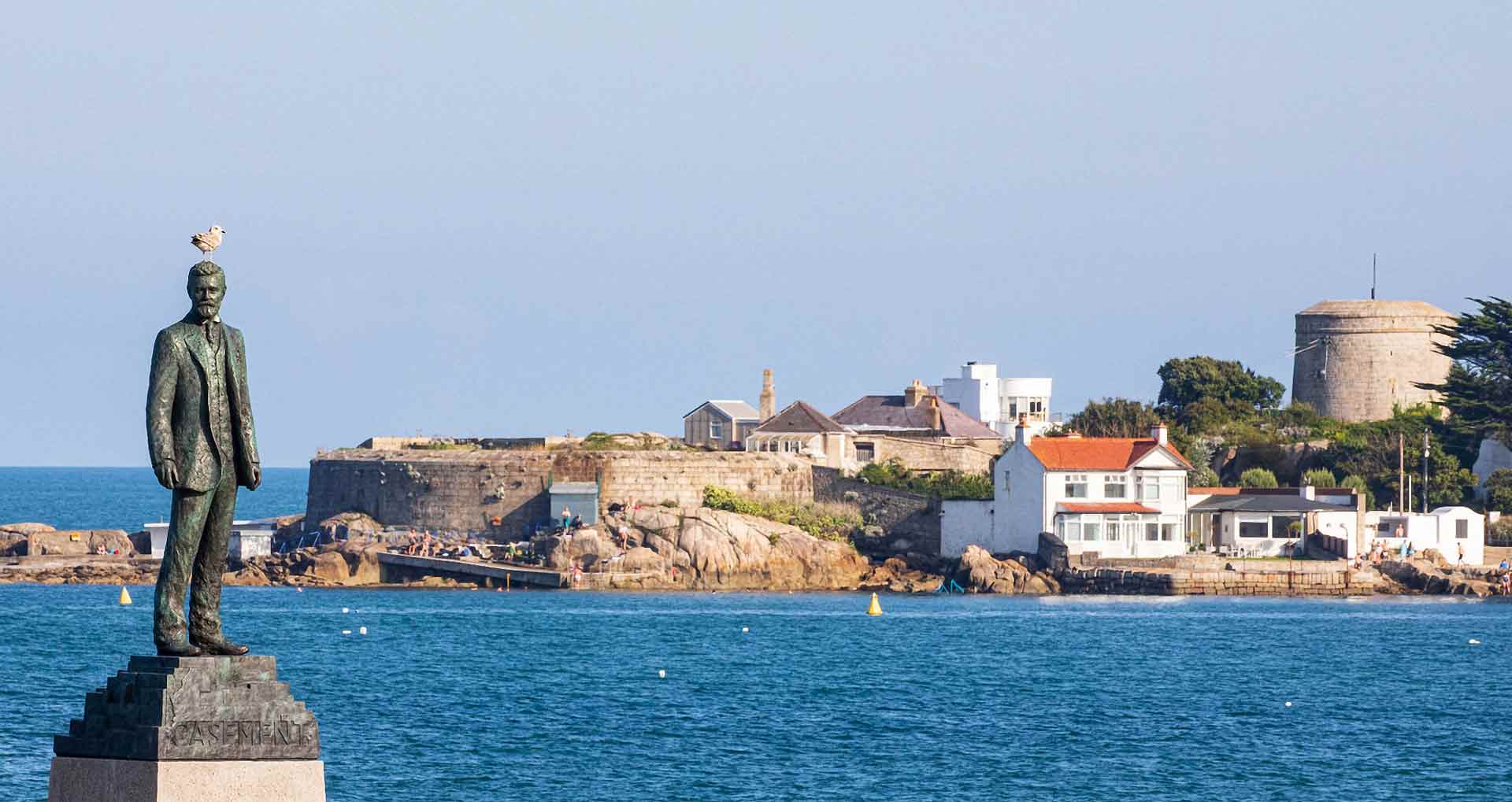THE CASEMENT MEMORIAL STATUE AND THE ‘NIGHTMARE OF HISTORY’
Published in Issue 4 (July/August 2022), News, Volume 30‘History … is a nightmare from which I am trying to awake’ is one of the more familiar metaphors from Joyce’s Ulysses. But what exactly did Joyce mean? One line of interpretation claims that ‘History’ is incapable of delivering either justice or enlightenment. It is a narrative that is violent, chaotic and perpetually oppressive.
With the appearance on the skyline of Dublin Bay of a new, green-tinted statue of Roger Casement juxtaposed against the Martello tower where the opening scenes of Ulysses are set, visitors to Dún Laoghaire have new perspectives for the contemplation of Stephen Dedalus’s ‘nightmare’. Located in the new baths’ development in Dún Laoghaire, the larger-than-life bronze rendering of Casement by sculptor Mark Richards stands at the end of a long jetty and strikes a pose that is both proud and defiant.

Above: The larger-than-life bronze rendering of Casement by sculptor Mark Richards, juxtaposed against the Martello tower where the opening scenes of Ulysses are set, strikes a pose that is both proud and defiant.
Efforts to raise a public statue to Roger Casement have been ongoing for over half a century. Casement was born in a house in Sandycove in 1864. He took his final steps in Ireland there, as he was escorted onto a boat in Kingstown (now Dún Laoghaire) on Easter Sunday 1916. In the decades after his execution, Casement’s association with Dún Laoghaire was kept alive in the affections and imaginations of many local citizens. During the 1940s and ’50s, a commemorative Mass was held each 3 August. Part of that tradition has been recently revived by the Roger Casement Summer School.
Dr Herbert Mackey, a respected dermatologist and resident of Dún Laoghaire, waged a campaign that pressurised both the British and Irish governments to repatriate Casement’s remains from an unmarked grave in Pentonville Prison.
To mark the return of Casement to Ireland and his reburial in Glasnevin Cemetery in 1965, Oisín Kelly completed a public sculpture of the Irish patriot. Kelly’s statue was based on a final image of the condemned man as he was led from the Royal Courts of Justice. The prisoner is handcuffed. His pose is steadfast but restrained. This is a rebel in the process of being silenced by the imperial system that he had exposed so boldly. By the mid-1960s, however, as British–Irish relations improved, there were concerns that tourists stepping off the ferry from the neighbouring island should not be confronted by a reviled ‘traitor’ executed in central London during the First World War. Kelly’s effigy remained in storage in the basement of the Office of Public Works, held erect by an electrical cable tied around the neck of the figure. There it remained until a newsagent from Ballyheigue lobbied his local TD to have the statue relocated to Kerry, where it stands today. The remote and windswept location for the sculpture mirrored the somewhat marginalised and awkward place that Casement occupied in the national commemorative imagination after the Troubles reignited in August 1969. In September 1984, on the eve of the unveiling of Kelly’s work in Ballyheigue by local TD and Tánaiste Dick Spring, the Marita Ann was captured off the coast of Kerry carrying an arms shipment. That confluence of the cultural remembering of Roger Casement with armed republicanism saw Casement’s memory exiled once more into the shadows.
His ghost was revived when the Royal Irish Academy held a conference on 5–6 May 2000. The symposium coincided with the declaration by ‘P. O’Neill’ of the Irish Republican Publicity Bureau of the intent to ‘initiate a process that will completely and verifiably put IRA arms beyond use’.
For the last two decades, Casement’s meaning has emerged in a new light as someone who can bridge political division and remove causes of conflict. One of his most ardent admirers is the gay rights activist Jeff Dudgeon MBE, a stalwart unionist who has self-published three editions of the ‘Black Diaries’ and harnessed Casement to his campaign for the recognition and liberalisation of gay rights, especially among conservative elements of both nationalist and loyalist communities north and south.
For Ireland’s Department of Foreign Affairs, Casement is upheld as a pioneer of humanitarian activism, whose investigations set down markers for their own independent foreign policy. During his State visit to Peru in 2017, Michael D. Higgins, Uachtarán na hÉireann, delivered a lecture on Casement’s humanitarian vision in the Palacio de Torre Tagle, headquarters of the Peruvian Ministry of Foreign Affairs.
Every statue is a political statement in a public space. Dún Laoghaire’s decision to commission this sculpture realises the long-held dream of many local citizens to raise a memorial to a revered revolutionary. But the foundations of this monument are as much a statement as a reckoning. That reckoning recognises a lineage of public intellectuals, independent historians and subaltern voices who have struggled to uncover deeper truths about Casement and his enduring struggles with the nightmare of History.
To supplement the installation, Dún Laoghaire County Council commissioned the historian Angus Mitchell to write The Casement Memorial Statue.
















